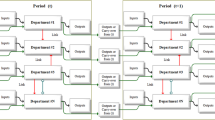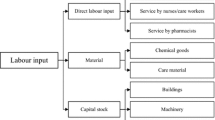Abstract
The objective of this study was to examine the change in efficiency of health care systems of 34 OECD countries between 2000 and 2012, a period marked by significant health reform in most OECD countries. This paper uses a novel Dynamic Network Data Envelopment Analysis (DNDEA) model to analyze the efficiency of the public health system and the medical care system of these OECD countries independently along with assessing the efficiency of their overall health system. This helps understand the relative priorities for improving the overall health system. The data for this study was obtained from the OECD Health Facts database. The study findings suggest that countries which improved their public health system were more likely to show overall improvement in efficiency.

Similar content being viewed by others
References
Afonso A, St Aubyn M (2006) Relative efficiency of health provision: A DEA approach with non-discretionary inputs. ISEG-UTL economics working paper, vol. 33
Aktan AO, Pala K, Ilhan B (2014) Health-care reform in Turkey: far from perfect. Lancet (London, England) 383(9911):25–26
Allin S, Mossialos E, McKee M, Holland W (2004) Making decisions on public health: a review of eight countries WHO. Retrieved from http://www.euro.who.int/__data/assets/pdf_file/0007/98413/E84884.pdf
Almond D, Chay KY (2006) The long-run and intergenerational impact of poor infant health: evidence from cohorts born during the Civil Rights Era. 2006. NBER working paper
Andersen PT, Jensen JJ (2010) Healthcare reform in Denmark. Scand J Public Health 38(3):246–252
Bambra C, Beckfield J (2011) Institutional arrangements as candidate explanations for the US mortality disadvantage. Background paper for the NAS/IOM panel on understanding international health differences in high-income countries. The National Academies/Institute of Medicine, Washington. Retrieved from http://scholar.harvard.edu/files/jbeckfield/files/bambra_and_beckfield_2012.pdf
Barros PP (2012) Health policy reform in tough times: the case of portugal. Health Policy 106(1):17–22
Bazile J, Rigodon J, Berman L, Boulanger VM, Maistrellis E, Kausiwa P, Yamin AE (2015) Intergenerational impacts of maternal mortality: qualitative findings from rural Malawi. Reprod Health 12(Suppl 1):S1
Benneyan J, Ceyhan M, Sunnetci A (2007) Data envelopment analysis of national healthcare systems and their relative efficiencies. Paper presented at the the 37th international conference on computers and industrial engineering, pp 251–261
Boutsioli Z (2011) A promising health care reform in greece: the emphasis is on hospitals. Int J Healthc Deliv Reform Initiat (IJHDRI) 3(2):23–27
Bunker JP, Frazier HS, Mosteller F (1994) Improving health: measuring effects of medical care. Milbank Q 72(2):225–258
Byrkjeflot H (2004) The making of a health care state? An analysis of the recent hospital reform in Norway. Paper Presented at the EGOS Colloquum, Lubljana, 1–4 July 2004
Centers for Disease Control and Prevention (1999) Ten great public health achievements-United States, 1900–1999. Morb Mortal Wkly Rep 48(12):241–243
Cutler DM, Miller G (2005) The role of public health improvements in health advances: the twentieth-century United States. Demography 42(1):1–22
Färe R, Grosskopf S, Norris M, Zhang Z (1994) Productivity growth, technical progress, and efficiency change in industrialized countries. Am Econ Rev 84(1):66–83
Färe R, Grosskopf S (2000) Network DEA. Socio Econ Plan Sci 34:35–49
Fielding J, Tilson H, Richland J (2008) Medical care reform requires public health reform: expanded role for public health agencies in improving health. Partnership for prevention. Retrieved from https://www.prevent.org/data/files/initiatives/medicalcarereformrequirespublichealthreform.pdf
Foege WH (2004) Redefining public health. J Law Med Ethics 32(Suppl. 4):S23–S26
Gaal P (2011) Health systems in transition: Hungary: health system review. European observatory on health systems and policies. Retrieved from http://www.euro.who.int/__data/assets/pdf_file/0019/155044/e96034.pdf
Gerlinger T (2010) Health care reform in Germany. Ger Policy Stud 6(1):107–142
Goldstein MS, Siegel JM, Boyer R (1984) Predicting changes in perceived health status. Am J Public Health 74(6):611–614
Gruber J, Sekhon JS (2010) Fundamental health care reform for the United States. Significance 7(3):122–127
Häkkinen U, Joumard I (2007) Cross-country analysis of efficiency in OECD health care sectors. Retrieved from http://www.oecd-ilibrary.org/docserver/download/5l4nrhnfdlzq.pdf?expires=1448751765&id=id&accname=guest&checksum=CDD17A7C01E839B8A3BE04D497AFD1E0
Hollingsworth B, Wildman J (2003) The efficiency of health production: re-estimating the WHO panel data using parametric and non-parametric approaches to provide additional information. Health Econ 12(6):493–504
Ikegami N, Campbell JC (2004) Japan’s health care system: containing costs and attempting reform. Health Aff 23(3):26–36
Kacak H, Ozcan YA, Kavuncubasi S (2014) A new examination of hospital performance after healthcare reform in turkey: sensitivity and quality comparisons. Int J Public Policy 10(4):178–194
Kawaguchi H, Tone K, Tsutsui M (2014) Estimation of the efficiency of japanese hospitals using a dynamic and network data envelopment analysis model. Health Care Manag Sci 17(2):101–112
Klopp GA (1985) The analysis of the efficiency of production system with multiple inputs and outputs. PhD dissertation, University of Illinois at Chicago, Industrial and System Engineering College
Kulesher R, Forrestal E (2014) International models of health systems financing. J Hosp Adm 3:127–139
Laurell AC (2007) Health system reform in mexico: a critical review. Int J Health Ser Plan Adm Eval 37(3):515–535
Magnussen J, Vrangbæk K, Saltman R (2009) Nordic health care systems: recent reforms and current policy challenges. McGraw-Hill Education, UK
McGinnis JM, Williams-Russo P, Knickman JR (2002) The case for more active policy attention to health promotion. Health Aff 21(2):78–93
Mirmirani S, Li H, Ilacqua JA (2011) Health care efficiency in transition economies: an application of data envelopment analysis. Int Bus Econ Res J (IBER) 7(2):47–56
Mohan R, Mirmirani S (2007) An assessment of OECD health care system using panel data analysis. Southwest Bus Econ J 16:21–25
Narcı HÖ, Ozcan YA, Şahin İ, Tarcan M, Narcı M (2015) An examination of competition and efficiency for hospital industry in Turkey. Health Care Manag Sci 18(4):407–418
National Health and Hospitals Reform Commission (Australia) (2009) A healthier future for all Australians: final report June 2009. Department of Health and Ageing. Retrieved from http://www.health.gov.au/internet/nhhrc/publishing.nsf/content/1AFDEAF1FB76A1D8CA257600000B5BE2/File/Final_Report_of_the%20nhhrc_June_2009.pdf
Nolte E, Knai C, Hofmarcher M, Conklin A, Erler A, Elissen A, Vrijhoef HJ (2012) Overcoming fragmentation in health care: chronic care in Austria, Germany and the Netherlands. Health Econ Policy Law 7(01):125–146
Office of the Government of the Czech Republic (2013) National reform programme of the Czech Republic 2013. Retrieved from http://www.vlada.cz/assets/evropske-zalezitosti/dokumenty/NPR-2013-v-PDF-_AJ_.pdf
Olejaz M, Juul A, Rudkjøbing A, Birk HO, Krasnik A (2012) Denmark: health system review: health systems in transition. World Health Organization, Copenhagen. Retrieved from http://www.euro.who.int/__data/assets/pdf_file/0004/160519/e96442.pdf
Ozcan YA (2014) Health care benchmarking and performance evaluation an assessment using data envelopment analysis (DEA), 2nd edn. Springer, Newton
Ravangard R, Hatam N, Teimourizad A, Jafari A (2014) Factors affecting the technical efficiency of health systems: a case study of economic cooperation organization (ECO) countries (2004–2010). Int J Health Policy Manag 3(2):63
Reid TR (2010) The healing of America: a global quest for better, cheaper, and fairer health care. Penguin, New York, NY
Retzlaff-Roberts D, Chang CF, Rubin RM (2004) Technical efficiency in the use of health care resources: a comparison of OECD countries. Health Policy 69(1):55–72
Rivera B (2001) The effects of public health spending on self-assessed health status: an ordered probit model. Appl Econ 33(10):1313–1319
Schafer W, Kroneman M, Boerma W, van den Berg M, Westert G, Deville W, van Ginneken E (2010) The Netherlands: health system review. Health Syst Trans 12(1):1–228
Simms C (2010) Health reform in Canada. Int J Clin Pract 64(4):426–428
Szalay T, Pazitny P, Szalayova A, Frisova S, Morvay K, Petrovic M, van Ginneken E (2011) Slovakia health system review. Health Syst Trans 13(2):1–174
Thomson S, Võrk A, Habicht T, Rooväli L, Evetovits T, Habicht J (2010) Responding to the challenge of financial sustainability in Estonia’s health system. World Health Organization Regional Office for Europe, Copenhagen
Tone K, Tsutsui M (2009) Network DEA: a slacks-based measure approach. Eur J Oper Res 197(1):243–252
Tone K, Tsutsui M (2014) Dynamic DEA with network structure: a slacks-based measure approach. Omega 42(1):124–131
Tussing AD, Wren MA (2006) How Ireland cares: the case for health care reform. New Island, Dublin
Unger J, De Paepe P, Cantuarias GS, Herrera OA (2008) Chile’s neoliberal health reform: an assessment and a critique. PLoS Med 5(4):e79
Woolf SH, Aron L (2013) US health in international perspective: shorter lives, poorer health. The National Academies/Institute of Medicine, Washington. Retrieved from https://obssr.od.nih.gov/pdf/IOM%20Report.pdf
Yaya S, Danhoundo G (2015) Introduction: special issue on innovations in health care system reform in OECD countries. Innov J 20(1):1
Author information
Authors and Affiliations
Corresponding author
Rights and permissions
About this article
Cite this article
Ozcan, Y.A., Khushalani, J. Assessing efficiency of public health and medical care provision in OECD countries after a decade of reform. Cent Eur J Oper Res 25, 325–343 (2017). https://doi.org/10.1007/s10100-016-0440-0
Published:
Issue Date:
DOI: https://doi.org/10.1007/s10100-016-0440-0




